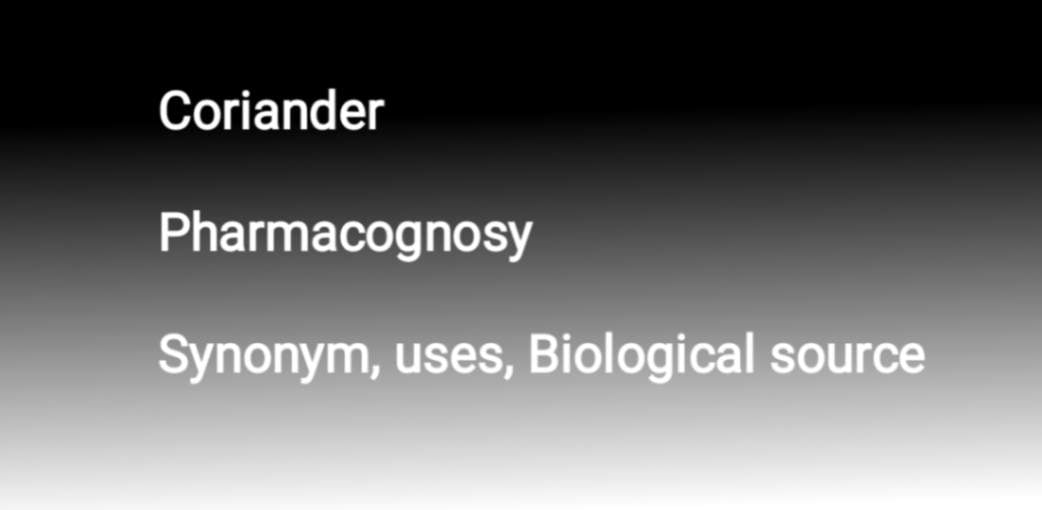Coriander Pharmacognosy 1 – Source, Uses, Tests hello friends welcome to our website here I am going to discuss about a crude drug which is carminative as coriander let us discuss the topics we are going to discuss are – coriander other name, coriander scientific name, coriander family, Cultivation and collection, coriander seeds, Microscopic characters, Chemical constituents, coriander benefits are the points we have discussed below.
Coriander

Coriander other name
Synonyms : coriander fruits, coriandrum are the two names for coriander.
Coriander scientific name
Biological source name These are fully dried ripe fruits of a plant known as Coriandrum sativum Linn. This fruit contains 0.3% of volatile oil.
Coriander family
It belongs to the family of Umbelliferae. Cremocarp which breaks at maturity into two parts without further division.
Geographical distribution :
These plants are cultivated in Europe,Russia, Hungary and Holland. In India, Egypt, Morocco. In India it is widely grown in Andhra, Maharashtra, west bengal, uttar pradesh and Jammu and kashmir.In many other parts of India coriander leaves are used in spices and cooking purpose and as a decorating the food at the time of serving. Also other parts of India have started cultivating coriander in large quantities.
Cultivation and collection
- Coriander is a kharif crop also a rabi crop. Gap between the months before sowing coriander seeds.
- Soil type is light to black soil. 15 to 21 kg of coriander fruits are sown for each hectare.
- Methods used for sowing seed are drilling.
- Harvesting is done after 100 days completion.
- In India 2 lakhs hectare land cultivates coriander.
- Cultivation of coriander is very easy just need a proper hard work.
Coriander seeds
- Colour : Yellowish brown to brown
- Odour : Aromatic
- Taste : Spicy and characteristics
- Size : seeds are 2 to 4 mm in diameter and 4 to 8 mm in length.
- Shape : Coriander is a sub globular cremocarpous seed fruit with about 10 primary ridges and 8 secondary ridges around it.
Important note of seeds
- Primary ridges are wavy and inconspicuous
- Secondary ridges are straight. It is endospermic and coelospermic.
- Weight of 100 seeds is 1 gram.
Microscopic characters
- Epidermis of pericarp is made of polygonal tabular cells with stomata
- Epidermal cells contains prism of calcium oxalate.
- Mesocarp it has inner and outer layer of parenchyma with layer of sclerenchyma in between.
- Inner epidermis has parquetry cells.
- Trichomes and lignified reticulate parenchyma is absent.
- There is no starch grains.
- Fixed oil globules are present in endosperm.
- While volatile oil present in vittae. Aleurone grains are present in polygonal thick walled cellulose parenchyma of endosperm.
For more such content Follow link
Chemical constituents
- Presence of 0.3% to 1% of volatile oil.
- Fixed oil percent is 13%.Proteins are 20 are the contents of drug.
- Volatile oil contains 90% of D-linalool which Is also called coriandrol.
- Smallest content of L- borneol and pinene.
- Coriander leaves are vitamin A rich.
Coriander benefits
- It is used as aromatic.
- It is used as carminatives
- It is a stimulant.
- It is used as a flavour agent in many spices.
- Coriander oil is used as purgative to prevent gripping.
- Gripping means gases formation which causes pain.
- It used as ingredients in spirit of orange and cascara elixir.
Substituents
It is substituted by bombay coriander fruits which has no or less volatile oil content and they can be identify by using their ellipsoidal shape.This substitute are added with coriander seeds.
Also yyou can read:
Neem Plant Pharmacognosy 1 -Synonym, Source, Uses link
Conclusion
So friends this was my article on coriander. Coriander is a carminative, flavouring agent widely used in maharashtra even housewife’s can easily plant this coriander in their house garden. If you like my article please tell me in comment section and don’t forget to share this valuable knowledge. Do subscribe us for more.










